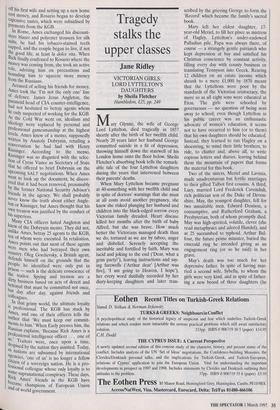Tragedy stalks the upper classes
Jane Ridley
VICTORIAN GIRLS: LORD INTTELTON'S DAUGHTERS by Sheila Fletcher Hambledon, £25, pp. 249 ary Glynne, the wife of George Lord Lyttelton, died tragically in 1857 shortly after the birth of her twelfth child. Nearly 20 years later her husband George committed suicide in a fit of depression, throwing himself down the stairwell of his London home onto the floor below. Sheila Fletcher's absorbing hook tells the remark- able tale of the four Lyttelton daughters during the years that intervened between their parents' deaths.
When Mary Lyttelton became pregnant at 40-something with her twelfth child and in spite of doctors' warnings that she must at all costs avoid another pregnancy, she knew she risked plunging her husband and children into the black-edged sorrow every Victorian family dreaded. Heart disease killed her months after the birth of baby Alfred, but she was brave. How much better the Victorians managed death than we do, tortured as we are by taboo, anger and disbelief. Serenely accepting the inevitable and fortified by faith, Mary was lucid and joking to the end (Dear, what a grim party!'), leaving instructions and say- ing farewells (Arthur dear' [Arthur was five], 'I am going to Heaven, I hope'), her every word dutifully recorded by her diary-keeping daughters and later tran- scribed by the grieving George to form the `Record' which became the family's sacred book.
Mary left her eldest daughter, 17- year-old Meriel, to fill her place as mistress of Hagley, Lyttelton's under-endowed Palladian pile. Papa was always there, of course — a strangely gentle patriarch who kept depression at bay and satisfied his Christian conscience by constant activity, filling every day with county business or translating Tennyson into Greek. Rearing 12 children on an estate income which shrank to a mere £1,000 by 1870 meant that the Lytteltons were poor by the standards of the Victorian aristocracy, the more so as all eight sons were educated at Eton. The girls were schooled by governesses — no question of being sent away to school; even though Lyttelton in his public career was an enthusiastic advocate of women's education, it seems not to have occurred to him (or to them) that his own daughters should be educated. Instead, they learned to run Hagley on a shoestring, to mind their little brothers, to ride, to chatter and, above all, to write copious letters and diaries, leaving behind them the mountain of papers that forms the material for this book.
Two of the sisters, Meriel and Lavinia, made unadventurous but fertile marriages to their gifted Talbot first cousins. A third, Lucy, married Lord Frederick Cavendish, rich politician son of the Duke of Devon- shire. May, the youngest daughter, fell for two unsuitable men, Edward Denison, a consumptive, and Rutherford Graham, a Presbyterian, both of whom promptly died. May was high-spirited, volatile, clever (she read metaphysics and adored Handel), and at 25 succumbed to typhoid. Arthur Bal- four, the future prime minister, buried the emerald ring he intended giving as an engagement ring (or so he said) in her grave.
May's death was too much for her depressive father. In spite of having mar- ried a second wife, Sybella, to whom the girls were very kind, and in spite of father- ing a new brood of three daughters (he adored babies), George sank into the appalling depression which ended in his suicide. Saddest of the sisters was Lucy, the one everyone loved most. Though child- lessness was a sorrow, her marriage to Fred Cavendish was blissfully happy in the way that childless marriages sometimes are; but Fred was murdered in Phoenix Park, Dublin, in 1882 by an Irishman who didn't even know that his victim was the newly appointed Irish Chief Secretary. Lucy, whose extrovert gaiety masked her father's manic depressive temperament, never real- ly recovered from Fred's loss.
Sheila Fletcher's finely judged account is a reminder of the tragedy that stalked the lives of the Victorian upper classes. What emerges most strikingly is the strength and resilience of the sisters. Their emotional closeness enabled them to survive a succes- sion of blows which might surely have crushed their 20th-century great-grand- daughters, university degrees or not. It's a pity, though, that Sheila Fletcher pays so Tittle attention to the brothers. The eight Lyttelton sons figure here as boisterous, cricket-crazed, napkin-throwing public- school boys, winning prize after prize at Eton and Cambridge. Yet their worldly success was achieved in spite of an 'almost incapacitating diffidence'; a tribe of strange, unworldly eccentrics, they too deserve the sympathetic treatment that the author has given their sisters.



























































 Previous page
Previous page